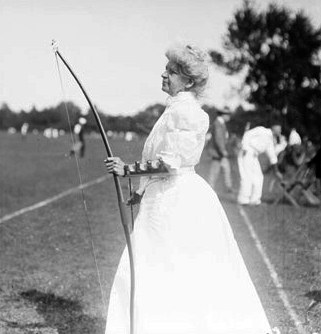In any “archery facts” post you’re going to find, you’re going to end up reading about the Olympics, so we figured we’d write an article where we focus specifically on the Big Games. So here it is: our favorite facts about Olympic archery. First up!

The Incredible Disappearing Sport
Archery first made its debut at the modern Olympic Games in Paris in 1900. The competition itself lasted an incredible 44 days (back then the Olympics were for rich people, apparently), and actually included a crossbow program, which is kind of a bummer, because there’s no crossbow event today, and we’d love to see it.
Archery was hugely popular, and part of the Olympic Games in 1904 and 1908—and then, in 1912, for reasons we couldn’t find, it was completely dropped. In 1916 there were no Olympic Games because of World War I, and then in 1920, only three countries competed: Belgium, France, and the Netherlands (there’s a rumor that there were no archers in the 1920 Games, but that’s not correct).
After that, it wasn’t included until 1972.
No team events, no individual events, nothing. The strange thing is, we can find very little about why it wasn’t included. Lack of interest? Some weird geo-political plot against the world’s oldest sport? TV rights? We have no idea. If you do know, hop over to our “Contact” page, and fill us in! We’re all ears.
Archery, Birds, and LIES
Have you ever heard of Cunningham’s Law? It goes something like this: “If you’re on the internet and you want the right answer, don’t ask a question—post an incorrect answer.”
In other words, if you want to make sure that Abraham Lincoln was our 16th president, go online to your favorite forum and proudly say, “I love Abraham Lincoln, who was our 78th president!” and within minutes you’ll have dozens of people reminding you that Abraham Lincoln was our 16th president, and that you’re a dummy.
A website—we won’t mention which one—posted that archers in the 1900 Olympic Games in Paris shot at live birds instead of targets. The would be fascinating if it were true, but it’s not, and it seems like a lot of sites are “parroting” (ha) that misinformation.
Archers in the 1900 Olympic games could compete in a couple of different events, including regular target archery, a couple of crossbow events, and pole archery (aka, “popinjay”), which used to be pretty popular but is now pretty rare. In popinjay, an archery shoots at a “bird” at the top of a pole, which is actually just a piece of wood carved to look like a bird, or a bundle of feathers meant to look like a bird.
So, the “archers shooting at birds” thing is a myth, and one that’s sadly being spread by a lot of archery sites.
Nice Shot, Man
Archery is currently a mainstay in the Olympic Games, and while it may not be as exciting as, say, boxing or badminton, it’s still pretty spellbinding. Many argue, though, that the most spellbinding Olympic archery moment came in 1992, in Barcelona, when a Spanish Paralympic archer Antonio Rebollo shot a flaming arrow seven stories into the air, above the crowd, to light the Olympic torch.
It’s a pretty intense moment, and here’s Antonio Rebollo explaining it in his own words:
(Editor’s Note: I actually remember watching that opening ceremony, and when he drew back the flaming arrow and released into the night—that was a tense couple of moments. But when the cauldron erupted into flame—WOW. Olympic theatricality at its finest.)
There are a few killjoys who insist that Antonio Rebollo didn’t actually hit the target, because he was actually aiming for a sandbox behind the stadium, but those people are lame and need to relax and enjoy a truly incredible Olympic moment.
South Korea is King
Remember how we said before that archery wasn’t re-included into the Olympic Games until 1972? Well, since then, South Korea has absolutely dominated the activity. They pretty much run the show, and let other countries show up, just because they’re good sports. They have more Olympic gold medals than any other country, and in the 2016 Games in Rio de Janeiro, they took gold in each of the four categories: men’s individual, women’s individual, men’s team, and women’s team.
Not only that, but they’ve won every women’s event since 1988. That’s more than three decades ago. That’s… honestly, credit where credit is due—that’s just an incredible run of skill and discipline.
Women Who Rock the Bow
The first modern Olympics Games were held in Greece in 1896, and each of the events included strict rules—but there was one strict set of not-at-all-fair rules that applied to the entire Games: No Girls Allowed.
It was pretty unfair, but all that changed in 1900 at the Paris games, and women competed in five sports: tennis, sailing, gold, equestrian, and croquet.
That’s right: croquet. Croquet, with the mallets and wickets and colorful wooden balls, was an Olympic sport. We want to make fun of croquet, and compare your average croquet athlete to say, your average decathlete, but who are we kidding: we’d totally watch croquet at the Olympics.
So while women weren’t allowed to compete in archery in 1900, they were invited to compete at the 1904 Olympics in St. Louis, Missouri. So while we weren’t the original good guys when it came to women having their rightful spot at the games, we were among the first, and that’s something.
The First Female Olympic Medalist Was an Archer
When you usually think of Olympians, you think of young, fit athletes at the prime of their lives. Powerful 20-somethings who pretty much have super-human abilities. That’s not the case for Olympian Eliza Pollock, however.
Born in 1840 in Hamilton, Ohio, Lida Peyton “Eliza” Pollock represented the United States in the 1904 Olympics, and took home a gold medal in the Women’s Team round, and two bronzes in the Women’s Doubles round. She was 63 years old when she earned those medals, and that makes her the oldest female medalist in the history of the Olympics. Here she is, looking pretty regal:

Here’s the twist: even though she gets a lot of notoriety for being the oldest female to medal, Pollock wasn’t the best archer of her generation—not by a longshot. That honor would go to Lida Scott Howell, who won 17 National Championships in the 24 years between 1883 and 1907, and won the gold medal in 1904 for the individual women’s archery event. That is pretty darn dominant.
Speaking of Pretty Dominant…
If we’re speaking of women who dominate the field, we have to mention Khatuna Lorig. She is, in a word, a powerhouse.
Lorig was born in Georgia, a nation next to the Turkey on the Black Sea. She started her archery training in the sixth grade, in a tradition so strict that she had to practice eight months of holding a bow before she was allowed to draw with an arrow. That’s… pretty intimidating. That’s something you’d see in a movie, where the director is trying to show you a dedicated archery coach, who’s also an absolute psychopath.
All that strict training paid off, though, because by the time she was 18, Lorig was competing at the 1992 Barcelona Olympics (while four months pregnant, and hiding it!), where she won bronze in the women’s team competition. She then competed in the 1996 and 2000 Olympics, became a U.S. citizen, and then competed for U.S. at the 2008 Olympics. Even though the 2008 Games were her last Olympic games, she’s remained competitive at a global level, and won gold on the mixed team at the 2010 World Cup Final and then individual gold at the 2015 Pan American Games. That is what an archery career can look like, and it’s an incredible run over many decades.
That kind of skill usually extends past sporting events, though, and Lorig has actually been asked to train actors and actresses who need to use archery in their cinematic roles. She was Jennifer Lawrence’s archery coach on The Hunger Games films, and it’s actually an interesting detail that the producers of that movie chose Lorig to train Lawrence—just like Katniss Everdeen in The Hunger Games, Lorig grew up in a severe environment, and her bow was her way out. Wait—is Lorig the inspiration for Hunger Games? Discuss.
“He’s So Cold, and Doesn’t Pay Attention to Me”
So this next archery fact doesn’t strictly pertain to the Olympics, but it’s too interesting / fascinating / weird to leave out.
Erika Eiffel—born Erika LaBrie—is a very talented archer: she first picked up a recurve in 1999, and then picked up a compound in 2000, and only four years later, she had won gold at the Texas Shootout, the Gold Cup, and the Arizona Cup (which comprise the three National Cup tournaments). That’s a pretty quick ascent up the archery ladder, and that itself is pretty noteworthy.
What’s truly interesting about Erika, though, is that she fell in love with the Eiffel Tower, and married it in a commitment ceremony in 2008.
Didn’t see that coming, did you?
Erika met the Eiffel Tower in 2004, and said she felt an immediate attraction.
Our question is… why did they wait until 2008? Was he dragging his feet? Was he previously married to the Tower of Pisa, and having a hard time retracting himself from that relationship? Or was because of the age difference? The Eiffel Tower is currently 180-something years old, and you know, old guys get set in their ways.
Anyway, if you’d like to know more, a documentary team put together a film titled Married to the Eiffel Tower. We haven’t seen the film, so we can’t recommend it, but we can let you know that it’s a thing.
A Couple of Facts and Figures
That wraps up our “weird facts about Olympic archery” post, but we’ll leave you with two facts that are kind of mind-boggling: during the events of an Olympic games, the average archer will have pulled four tons of weight, and shot arrows that travel faster than 150 miles per hour (or 240 kilometers per hour, for our friends overseas). Amazing!


